Hiya everybody! K and I are back from our five-day trek in the Salkantay region of Peru. It was fabulous and we feel quite fortunate to have booked the tour with a respectable company hiring top-of-the-line chefs and guides.
As you probably know, we don´t typically hire guides for our outdoor adventures. When you´re traveling internationally, though, I think it can be worthwhile to pay somebody else to handle the logistics. This was certainly true for a hike to Machu Picchu, the most popular attraction on the entire continent of South America!
Man, was it ever worth it. The trip involved four bus rides, one train ride, a hotel stay, and three nights of camping. The food was absolutely outstanding — we were offered the entire range of Peruvian classics, from Chicha Morada (a drink made from a native variety of blue corn) to Lomo Saltado (stir-fried beef) to Rocoto Relleno (stuffed roasted red pepper). I could easily dedicate an entire post to the food — each meal had at least three dishes (even breakfast), usually with a soup starter.
We went with Salkantay Trekking, mostly because of their superior website and above-average price (paying a little more for a reputable company seemed like a good idea). After a pre-trip briefing the night before the trip, we headed back to our hostel in Cusco and packed up. They gave us a good-sized duffle bag per person that would be carried by horse or bus between camps (score!) so we didn´t need to go super-light as on a typical backpacking trip. We woke up at 4am in order to be ready to be picked up by 430 — sure enough, Ramiro, our intrepid leader, was there to grab us. We picked up the other four people in our group, two Canadians and two Brits, and set off on a three-hour bus ride to Mollapata, the starting point of our hike. Along the way we stopped at a Restaurante “Turistico” (a sure sign of mediocre food) for a breakfast of eggs, fruit, bread and coffee.
The first day was a relatively easy hike up 8km or so to our first camp, at the end of the road. We had great views of Humantay (5,917m/19,400ft), a rather intimidating-looking glaciated peak to the North. Much of the walk was adjacent to a still-in-use aqueduct built by the Incas several centuries ago. It was a gorgeous path, smooth, flat, and gradually traversing a mountainside with the river raging one thousand feet below. Periodically we would stop to take a break and Ramiro would explain a bit of Inca history or to describe some of the flora along the trail. A native Cusqueñan, he was obviously quite proud of his heritage and eager to share the natural and cultural wonders of the region.

Incan aqueduct
By noon we had reached Soraypampa, a tiny settlement in a wide valley flanked by huge mountains on all sides. The company had set up semi-permanent structures for our tents as well cook tents, helping to keep out the bitter chill of the area, at around 3800m (12,500ft) The six of us saddled up around a table in one of the tents for lunch and were pleasantly surprised with a multi-course meal with plenty of tea to keep us hydrated. Then, we were allowed a few hours’ rest before setting off on a hike up to Humantay Lake to aid with acclimatization. K and I happily napped, and woke up with plenty of time to start hiking.
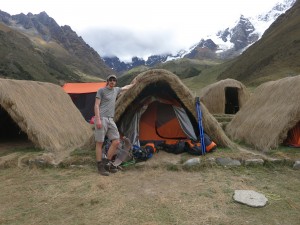
Home sweet home
The hike was a gradual uphill, and after an hour and a half we crested a hill to the base of the lake, at a lofty 4,270m (14k ft). Humantay towered above us and occasionally sloughed off pieces of its glacier with a roar, creating a dramatic atmosphere. We hung out for a half hour or so before it started to get chilly. The hike down seemed long but went quickly. After a few minutes’ rest we were announced that “happy hour” was ready. This was really just a euphemism for afternoon tea, as we were served various biscuits, cookies, and occasionally something more ornate like a savory pie, along with coca or another herbal tea.
Happy hours were generally the most social times of the trek, as we had a couple of hours on a daily basis to get to know our trekking partners. We talked about travel, national identities, and the usual subjects when people from differing nationalities gather (in our case all anglophones). Typically by seven dinner was served, and we gorged ourselves on traditional peruvian delicacies, especially impressive given the rustic environment. The trek served as an excellent and unexpected introduction to Peruvian cuisine!
That night was quite chilly (the coldest of the trek) and we were back in our tents by 8, as the plan was to rise by pre-dawn to get a head start on a big day, with 22km (14 miles) of hiking.
“Room Service” arrived punctually at 5am — a worker serving coca tea tent-side. We quickly packed up, ambled over to the dining tent for breakfast, ate, and were on the trail by 6:30. The day’s trek would be the hardest of the trip, involving an 800m climb up and over Salkantay pass at over 4600m (15,100ft), then back down the other side, dropping another 1800m to the next campsite. The clouds started to clear up just in time to reveal the massive Salkantay (6300m/21k ft) dominating the Eastern skyline. This time, the glacier was less than a couple kilometers away. We stopped a couple times along the way for snacks and were joined by 100+ tourists (mostly North Americans, seemingly). Luckily the path was quite large, more like a road, so it never seemed too bad. It just certainly wasn’t a wilderness experience.
By 10am or so we reached the pass. Ramiro explained the locals’ tradition of creating an offering for the Apu, or mountain, at the top of each major pass, and we all stoically placed the small stone we had each gathered at the trailhead. He tucked a coca leaf beneath our stones and we all said some words. There were hundreds of cairn-like piles of rock at the pass summit.
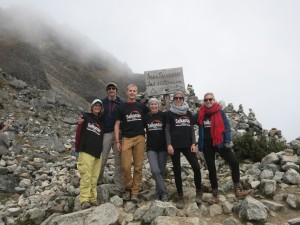
At the Pass!
With that as our climax, we began the knee-jarring descent, and by noon reached the next town, where we stopped for lunch. It was another delicious meal, but by the end, it was lightly drizzling outside with no signs of slowing down. So we all hunkered down in our raincoats and distracted ourselves with music or an audiobook. For the locals, of course, it was just another few miles in the rain. No biggie. During the hike, our environs almost imperceptibly changed from alpine tundra to jungle. The clouds would flow in and around the lush green mountainsides making for a gorgeous last few hours on an old Inca road. We made it to camp by 5pm or so for a long 11 hours of walking. The evening was similar to the last — hours of cheerful talking around a neverending spread of snacks, dishes and tea. Not too shabby for a quasi-backpacking trip!
Once again, after another tremendous night’s sleep (well, for me anyway) we rose pre-dawn for breakfast. The day’s hike would be another pretty one, starting on a road and then crossing a swollen river to a nice smooth path on the other side. In their usual enterprising fashion, a few of the locals had set up rest areas along the walk to sell snacks, water, and access to a real, flushing toilet . By noon we had reached another trailhead, which began the disjointed part of the trek. We were bussed to the nearest local town for lunch. Pretty much all the tour groups, maybe 60-80 people, were gathered on a second-floor deck for lunch. Our cooks showed off a bit with ornate centerpieces for each plate (Mr. Potatohead carved into a gourd, a shark crafted out of a potato) and we all stuffed ourselves silly. The rest of the day would involve nothing but sitting on a bus or bathing in hot springs, so there was no need to hold back.
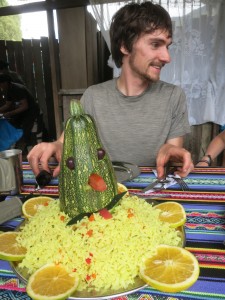
Nom nom
At this point we said farewell to our new British friends, Rachel and Ruby, as they had signed up for the four-day version of the same trek. They were off to Machu Picchu Pueblo that evening while we had an extra day in Santa Teresa (1600m). We enjoyed the natural hot springs with Matt and Ashley and were back to the camp spot by dusk. There we were sold, err, shown, a promotional video for a newly-established zipline operation nearby, which, of course, we had just enough time for the next morning!
The morning broke rainy again, so we delayed the zipline until 730 for the clouds to burn off. For those not in the know, a zipline is basically a thick steel cable suspended over a canyon. One wears a full-body harness and is attached to the line with a pulley, and you zip down the line, hopefully with enough momentum to pull yourself up the last bit at the other end. This one wasn’t too steep, but the longest was over 900m long (half a mile!) making for a nice long ride. It was fun, though my thorough desensitization from heights and exposure may have detracted from the experience. Doing a superman (where the pulley attaches behind you so you can ‘fly’) was pretty sweet though, as it did feel a bit like flying.
The rest of the day was fairly uneventful — we took a bus to Hidroelectrica, the ‘town’ at the end of the rail line to Machu Picchu Pueblo, and walked the rest of the way along the tracks. At one point we got a great view of the watchman’s hut way up high above the valley. This really piqued our excitement as Machu Picchu promised to be quite the grand finale!
Machu Picchu at last
At last, we woke up at the earliest time yet — 4am, in order to be at the gate for the road by 4:30 so we could be first in line to hike up to the park entrance. MP is incredibly popular, and most of the tourists take the bus, but if you maintain a fast pace you can beat the crowds to the gate and be some of the first people in. This really is worth it, as by 11am you’re walking in single file queues to get anywhere.
This is exactly what we did, as Ramiro set a blistering pace up the steep trail. We made it to the park gates at around 5:45, beating the first bus by 10 minutes or so — very satisfying when you’ve busted your ass walking up 1,800 vertical feet! Sure enough, our group was the first in. We headed straight in, and Ramiro gave us ten minutes or so to take it all in before starting the excellent tour.
What a breathtaking place — an ancient city perched on the rib of a mountain, surrounded on all sides by huge mountains, with a thousand foot drop into deep valleys to the North and South. Clouds swirled around us, occasionally lifting to reveal incredible vistas. We snapped pictures and soaked in the mystery of it all – quiet, majestic yet serene.
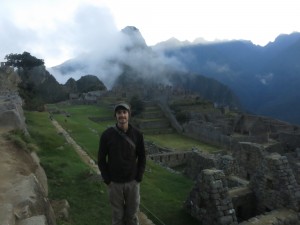
Psyched!
Ramiro started off with a brief history of the Incan Empire — Construction of MP began in the last few years before the Spanish invaded, and it was never completed. About 60% of what you currently see there was rebuilt — something I at first disliked, but about which have come around. The original ruins, while certainly authentic, would be much less impressive without the completed walls. Moreover, it is trivially easy to distinguish between the old and new, as the original construction is of a masterful quality.
Thus, we set off for the most interesting structures in the city. I won’t delineate each and every room of the visit, as my memory wouldn’t do them justice, but the tour was superb. Of special interest was the famous Inti Watana stone, serving as an astronomical clock and calendar. We were lucky enough to visit just after sunrise on June 22, the day after the winter solstice, on which the stone cast the second-longest shadow of the year. Later on, Ramiro brought to our attention a large carved rock which almost perfectly matched the silhouette of the mountainous eastern skyline — magnificent!
The tour lasted for a couple hours, hitting the most interesting spots in the city before winding back around to our original point. I was greatly inspired by the surroundings and couldn’t stop taking pictures, which I’ll post when we get back home. We said an emotional farewell to Ramiro, who by that point had assumed a bit of a fatherly figure after shepherding us around for five days, and went back to the entrance area for a break. There we said goodbye to Matt and Ashley, who were off to hike Huayna Picchu (the mountain in the background of all the classic MP pictures), and headed back in to tour the grounds by ourselves. We spent most of the day lounging around the upper terraces, reveling in the spectacular surroundings and general lack of people, before heading back down to the city for another look. Unfortunately, this didn’t last long as the hoards of people became a bit too much, and we reluctantly headed back down in the early afternoon. After another hour of descending we had a rather mediocre lunch in Aguas Calientes before doing a bit of shopping and coffee shop lounging, and were on the train back to civilization by 6pm.
What a great trek! We are enormously fortunate to have had the right combination of good company, a small group, an amazing guide, and excellent food, all for a rather moderate price. I wholeheartedly recommend Salkantay Trekking for your tour if you are headed Machu Picchu way — of course, ask for Ramiro!






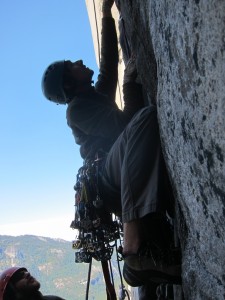
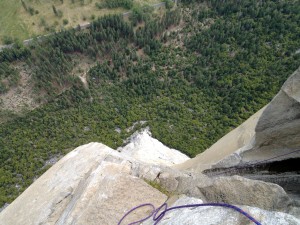
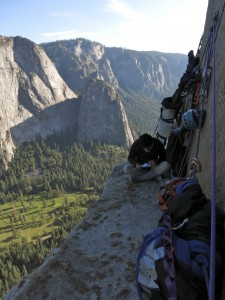
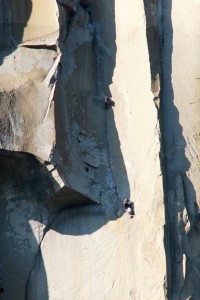
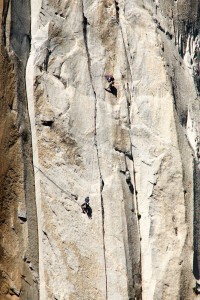
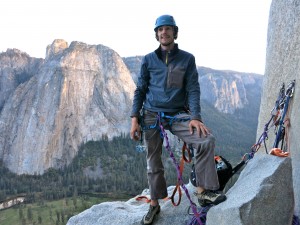
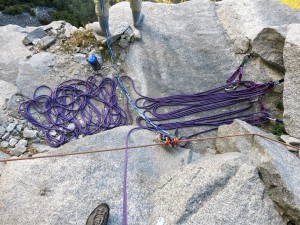
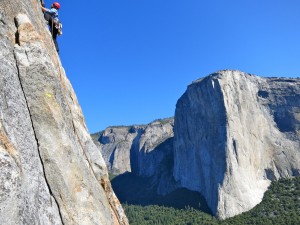
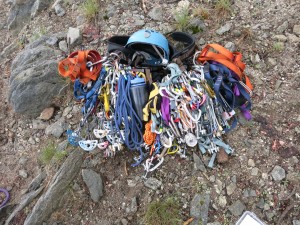
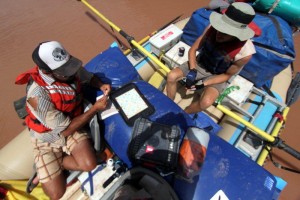

Recent Comments